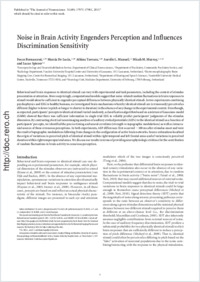Noise in brain activity engenders perception and influences discrimination sensitivity
- Bernasconi, Fosco Neuropsychology and Neurorehabilitation Service, Department of Clinical Neurosciences, Hospital Center and University of Lausanne, Switzerland - Department of Psychiatry, Community Psychiatry Service, Hospital Center and University of Lausanne, Switzerland
- De Lucia, Marzia Radiology Department, Vaudois University Hospital Center and University of Lausanne, Switzerland - Electroencephalography Brain Mapping Core, Center for Biomedical Imaging, Lausanne, Switzerland
- Tzovara, Athina Radiology Department, Vaudois University Hospital Center and University of Lausanne, Switzerland - Electroencephalography Brain Mapping Core, Center for Biomedical Imaging, Lausanne, Switzerland
- Manuel, Aurelie L. Neuropsychology and Neurorehabilitation Service, Department of Clinical Neurosciences, Hospital Center and University of Lausanne, Switzerland - Department of Psychiatry, Community Psychiatry Service, Hospital Center and University of Lausanne, Switzerland
- Murray, Micah M. Neuropsychology and Neurorehabilitation Service, Department of Clinical Neurosciences, Hospital Center and University of Lausanne, Switzerland - Radiology Department, Vaudois University Hospital Center and University of Lausanne, Switzerland - Electroencephalography Brain Mapping Core, Center for Biomedical Imaging, Lausanne, Switzerland - Department of Hearing and Speech Sciences, Vanderbilt University Medical Center, Nashville, USA
- Spierer, Lucas Neuropsychology and Neurorehabilitation Service, Department of Clinical Neurosciences, Hospital Center and University of Lausanne, Switzerland - Neurology Unit, Medicine Department, University of Fribourg, Switzerland
-
22.10.2011
Published in:
- The Journal of Neuroscience. - 2011, vol. 31, no. 49, p. 17971-17981
English
Behavioral and brain responses to identical stimuli can vary with experimental and task parameters, including the context of stimulus presentation or attention. More surprisingly, computational models suggest that noise-related random fluctuations in brain responses to stimuli would alone be sufficient to engender perceptual differences between physically identical stimuli. In two experiments combining psychophysics and EEG in healthy humans, we investigated brain mechanisms whereby identical stimuli are (erroneously) perceived as different (higher vs lower in pitch or longer vs shorter in duration) in the absence of any change in the experimental context. Even though, as expected, participants' percepts to identical stimuli varied randomly, a classification algorithm based on a mixture of Gaussians model (GMM) showed that there was sufficient information in single-trial EEG to reliably predict participants' judgments of the stimulus dimension. By contrasting electrical neuroimaging analyses of auditory evoked potentials (AEPs) to the identical stimuli as a function of participants' percepts, we identified the precise timing and neural correlates (strength vs topographic modulations) as well as intracranial sources of these erroneous perceptions. In both experiments, AEP differences first occurred ∼100 ms after stimulus onset and were the result of topographic modulations following from changes in the configuration of active brain networks. Source estimations localized the origin of variations in perceived pitch of identical stimuli within right temporal and left frontal areas and of variations in perceived duration within right temporoparietal areas. We discuss our results in terms of providing neurophysiologic evidence for the contribution of random fluctuations in brain activity to conscious perception.
- Faculty
- Faculté des sciences et de médecine
- Department
- Médecine 3ème année
- Language
-
- English
- Classification
- Biological sciences
- License
-
License undefined
- Identifiers
-
- RERO DOC 28781
- DOI 10.1523/JNEUROSCI.3715-11.2011
- Persistent URL
- https://folia.unifr.ch/unifr/documents/302292
Statistics
Document views: 106
File downloads:
- pdf: 158
